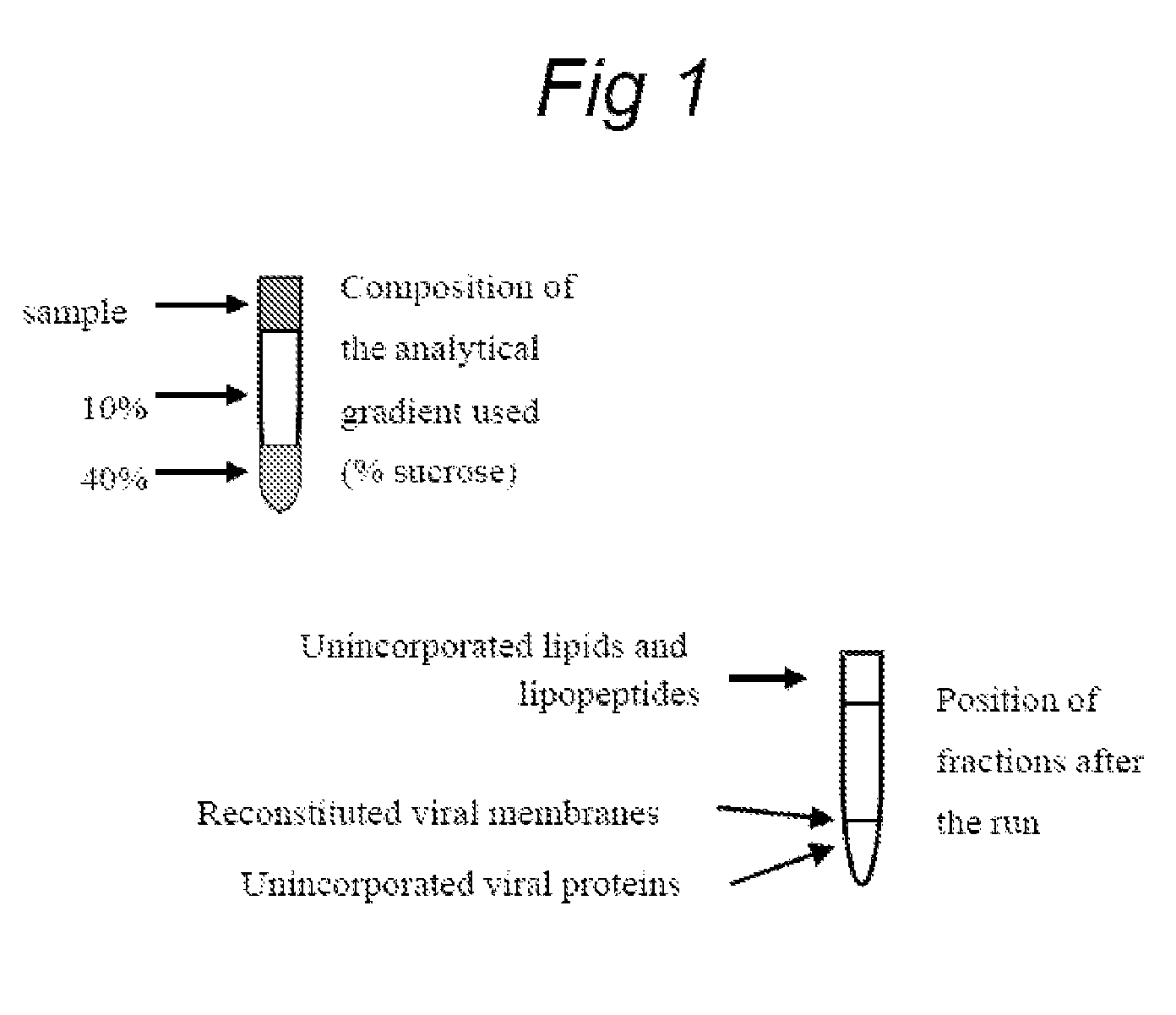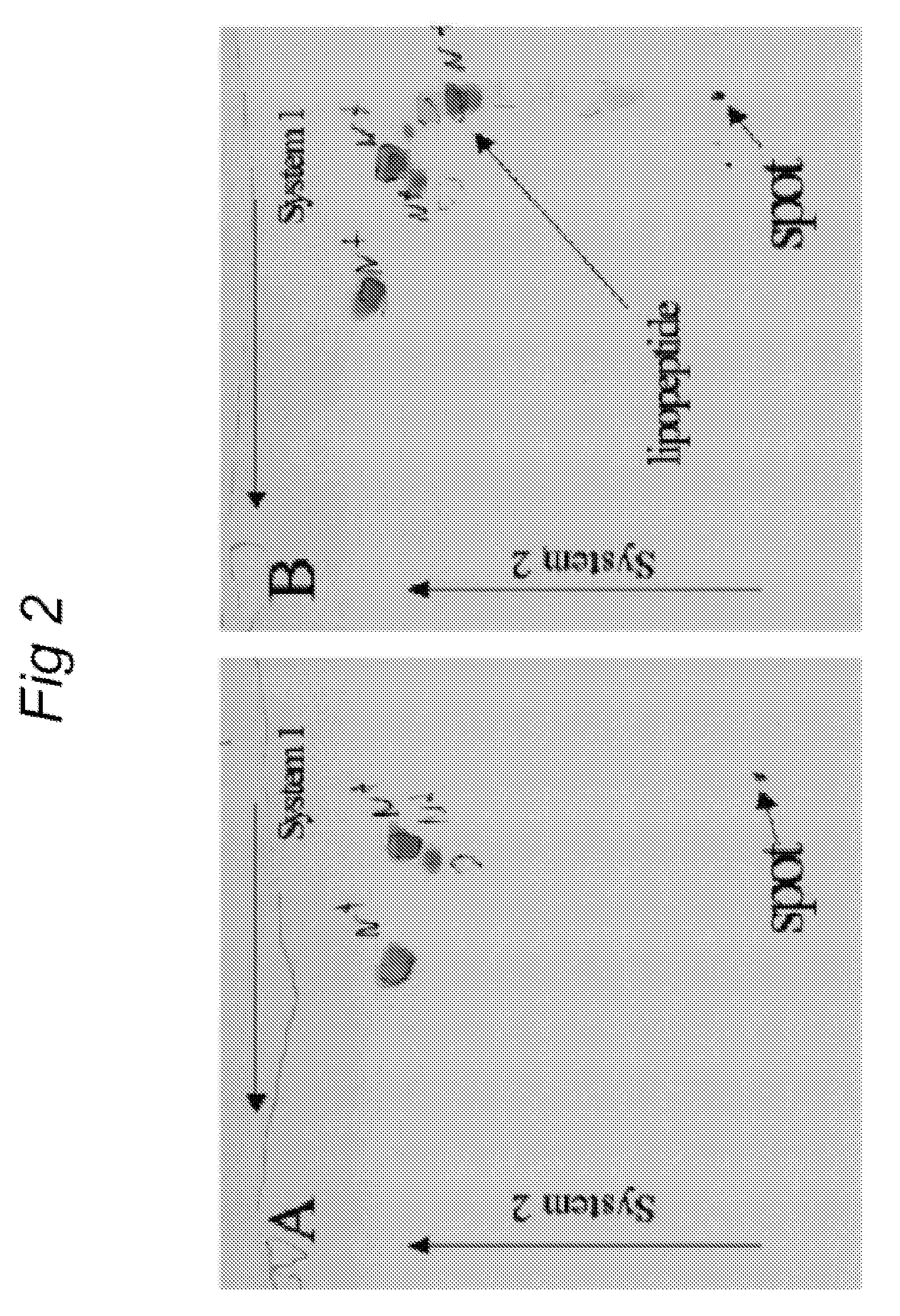Functionally reconstituted viral membranes containing adjuvant
a technology of viral membranes and adjuvants, applied in the field of vaccines, can solve the problems of bell's palsy, induced serious side effects, and limited immunogenicity of other virosome formulations, and achieve the effect of increasing the therapeutic and/or prophylactic efficacy of reconstituted viral membranes and good recognition of proteins presen
- Summary
- Abstract
- Description
- Claims
- Application Information
AI Technical Summary
Benefits of technology
Problems solved by technology
Method used
Image
Examples
example 1
Production of a Reconstituted Viral Membrane Containing the Lipopeptide N-palmitoyl-S-2,3(bispalmitoyloxy)-propyl-cysteinyl-seryl-(lysil)3-lysine, the Natural Lipids of Influenza Virus and the Influenza Membrane Proteins
[0048]Influenza virus was produced by growing virus acquired from the World Influenza Center or the American Type Tissue Culture Collection (ATCC), using methods known to persons skilled in the art, for instance by growing the virus on embryonated eggs or cultured cells. The virus was then purified, preferably by differential or density gradient ultracentrifugation or a combination thereof, and may subsequently be inactivated by beta-propiolactone or formaldehyde according to established standard procedures.
[0049]The purified and concentrated influenza A / Panama / 2007 / 9 virus (1500 nmol phospholipid) was incubated with 1 ml of the detergent octa(thylene glycol)-n-dodecyl monoether (C12E8) (Boehringer, Mannheim, Germany) at a concentration of 100 mM (a concentration abo...
example 2
Intranasal Immunization Experiments Using Reconstituted Viral Membranes Containing the Lipopeptide N-palmitoyl-S-2,3(bispalmitoyloxy)-propyl-cysteinyl-seryl-(lysil)3-lysine, the Natural Lipids of Influenza Virus and the Influenza Membrane Proteins
[0053]Vaccination by intranasal application of a reconstituted viral membrane containing the influenza virus hemagglutinin and N-palmitoyl-S-2,3(bispalmitoyloxy)-propyl-cysteinyl-seryl-(lysil)3-lysine, was compared to intranasal application of a standard subunit vaccine, or a virosome vaccine prepared according to EP 0538437. Balb / C mice were immunized by a intranasal instillation of 10 microliters of antigen containing 5 μg of influenza proteins, on days 0, and 14. Blood samples were taken on day 0, 14, and 35, nasal and lung washes were collected on day 35. Several different strains of influenza virus were compared; mice were immunized with one type of strain each. Lung washes were performed by injection of 1.5 ml of PBS into the lungs vi...
example 3
Membrane Fusion Activity of a Reconstituted Viral Membrane Containing the Lipopeptide N-palmitoyl-S-2,3(bispalmitoyloxy)-propyl-cysteinyl-seryl-(lysil)3-lysine, the Natural Lipids of Influenza Virus, Pyrene-labeled Phosphatidylcholine, and the Influenza Membrane Proteins
[0054]Purified and concentrated influenza A / Panama / 2007 / 9 virus (1500 nmol phospholipid) was incubated with 1 ml of octa(ethylene glycol)-n-dodecyl monoether (C12E8) at a concentration of 100 mM, for 10 min at 4° C., in an isotonic buffer at neutral pH: 145 mM NaCl, 2.5 mM HEPES, 1 mm EDTA, pH 7.4 (Buffer A). The viral nucleocapsid and matrix protein were then removed by centrifugation at 100,000×g for 30 min at 4° C. The pellet was discarded. The supernatant was mixed with the dry lipopeptide and pyrene-labeled phospholipid at a ratio of 0.5 mg lipopeptide and 150 nmol 1-hexadecanoyl-2-(1-pyrenedecanoyl)-sn-glycero-3-phosphatidylcholine per 750 nmol of viral lipid, and mixed until the lipopeptide and pyrene-labeled ...
PUM
| Property | Measurement | Unit |
|---|---|---|
| diameter | aaaaa | aaaaa |
| concentration | aaaaa | aaaaa |
| emission wavelengths | aaaaa | aaaaa |
Abstract
Description
Claims
Application Information
 Login to View More
Login to View More - R&D
- Intellectual Property
- Life Sciences
- Materials
- Tech Scout
- Unparalleled Data Quality
- Higher Quality Content
- 60% Fewer Hallucinations
Browse by: Latest US Patents, China's latest patents, Technical Efficacy Thesaurus, Application Domain, Technology Topic, Popular Technical Reports.
© 2025 PatSnap. All rights reserved.Legal|Privacy policy|Modern Slavery Act Transparency Statement|Sitemap|About US| Contact US: help@patsnap.com



